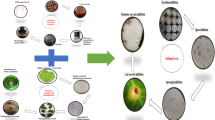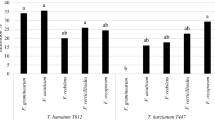Abstract
Plant diseases constitute an emerging threat to global food security. Many of the currently available antifungal agents for agriculture are highly toxic and nonbiodegradable and cause extensive environmental pollution. Moreover, an increasing number of phytopathogens are developing resistance to them. Therefore, the aim of this study was to assess the antifungal efficacy of the leaf essential oil and the leaf extracts of Metasequoia glyptostroboides against Fusarium oxysporum, Fusarium solani, Phytophthora capsici, Colletotrichum capsici, Sclerotinia sclerotiorum, Botrytis cinerea and Rhizoctonia solani. The oil (1,000 μg/disc) and the extracts (1,500 μg/disc) revealed a remarkable antifungal effect against the tested plant pathogenic fungi with a radial growth inhibition percentage of 41.3–66.3% and 13.4–54.4%, respectively along with their respective MIC values ranging from 62.5 to 1,000 μg/ml and 500–4,000 μg/ml. The oil had a strong detrimental effect on spore germination of all the tested plant pathogens along with the concentration as well as time-dependent kinetic inhibition of Botrytis cinerea. Also, the oil exhibited a potent in vivo antifungal effect against Phytophthora capsici on greenhouse grown pepper plants. The results of this study indicate that the oil and extracts of M. glyptostroboides leaves could become natural alternatives to synthetic fungicides to control certain important plant fungal diseases.







Similar content being viewed by others
References
Montesinos E (2007) Antimicrobial peptides and plant disease control. FEMS Microbiol Lett 270:1–11
Savary S, Teng PS, Willocquet L, Nutter FW (2006) Quantification and modeling of crop losses: a review of purposes. Annu Rev Phytopathol 44:89–112
Paster N, Bullerman LB (1988) Mould spoilage and mycotoxin formation in grains as controlled by physical means. Int J Food Microbiol 7:257–265
Knight SC, Anthony VM, Brady AM, Greenland AJ, Heaney SP, Murray DC, Powell KA, Schulz MA, Spinks CA, Worthington PA, Youle D (1997) Rationale and perspectives on the development of fungicides. Annu Rev Phytopathol 35:349–372
Brent KJ, Hollomon DW (1998) Fungicide resistance: the assessment of risk. FRAC, Global Crop Protection Federation, Brussels, pp 1–48
Barnard M, Padgitt M, Uri ND (1997) Pesticides use and its measurement. Inter Pest Control 39:161–164
Daoubi M, Hernandez-Galan R, Benharref A, Collado IG (2005) Screening study of lead compounds for natural product-based fungicides: antifungal activity and biotransformation of 6-alpha, 7-alpha-dihydroxy-betahimachalene by Botrytis cinerea. J Agric Food Chem 53:6673–6677
Walsh TJ, Viviani MA, Arathoon E, Chiou C, Ghannoum M, Groll AH, Odds FC (2000) New targets and delivery systems for antifungal therapy. Med Mycol 38(1):335–347
Barker KS, Rogers PD (2006) Recent insights into the mechanisms of antifungal resistance. Curr Infect Dis Rep 8:449–456
Duke SO (1990) Natural pesticides from plants. In: Janick J, Simon JE (eds) Advances in new crops. Timber Press, Portland, pp 511–517
Costa TR, Fernandes FLF, Santos SC, Oliveria CMA, Liao LM, Ferri PH, Paulo JR, Ferreira HD, Sales BHN, Silva MRR (2000) Antifungal activity of volatile constituents of Eugenia dysenterica leaf oil. J Ethnopharmcol 72(2):111–117
Negi PS, Chauhan AS, Sadia GA, Rohinishree YS, Ramteke RS (2005) Antioxidant and antibacterial activities of various seabuckthorn (Hippophae rhamnoides L.) seed extracts. Food Chem 92:119–124
Bajpai VK, Kang SC (2009) Potential role of leaf essential oil and extracts of Metasequoia glyptostroboides Miki ex Hu to inhibit the growth of Listeria monocytogenes spp. J Food Biochem (in press)
Duru ME, Cakir A, Kordali S, Zengin H, Harmandar M, Izumi S, Hirata T (2003) Chemical composition and antifungal properties of essential oils of three Pistacia species. Fitoterapia 74:170–176
Murray PR, Baron EJ, Pfaller MA, Tenover FC, Yolke RH (1995) Manual of clinical microbiology vol 6. ASM, Washington
Leelasuphakul W, Hemmanee P, Chuenchitt S (2008) Growth inhibitory properties of Bacillus subtilis strains and their metabolites against the green mold pathogen (Penicillium digitatum Sacc.) of citrus fruit. Postharvest Biol Tech 48(1):113–121
Rana BK, Singh UP, Taneja V (1997) Antifungal activity and kinetics of inhibition by essential oil isolated from leaves of Aegle marmelos. J Ethanopharmacol 57:29–34
Lee SE, Park BS, Kim MK, Choi WS, Kim HT, Cho KY, Lee SG, Lee HS (2001) Antifungal activity of pipernonaline, a piperidine alkaloid derived from long pepper. Piper longum L., against phytopathogenic fungi. Crop Prot 20:523–528
Pandey DK, Tripathi NN, Tripathi RD, Dixit SN (1982) Fungitoxic and phytotoxic properties of the essential oil Caesulia axillaris Roxb. Angewan Bot 56:259–267
Morris JA, Khettry A, Seitz EW (1979) Antimicrobial activity of aroma chemicals and essential oils. J Am Oil Chem Soc 56:595–603
Bajpai VK, Rahman A, Kang SC (2007) Chemical composition and antifungal properties of the essential oil and crude extracts of Metasequoia glyptostroboides Miki ex Hu. Ind Crop Prod 26:28–35
Sidhu OP, Chandra H, Behl HM (2009) Occurrence of aflatoxins in mahua (Madhuca indica Gmel.) seeds: synergistic effect of plant extracts on inhibition of Aspergillus flavus growth and aflatoxin production. Food Chem Toxicol 47:774–777
Gudzic B, Djokovic D, Vajs V, Palic R, Stojanovic G (2002) Composition and antimicrobial activity of the essential oil of Hypericum maculatum Crantz. Flavour Frag J 17(5):392–394
Cakir A, Kordali S, Zengin H, Izumi S, Hirata T (2004) Composition and antifungal activity of essential oils isolated from Hypericum hyssopifolium and Hypericum heterophyllum. Flavour Frag J 19(1):62–68
Bajpai VK, Kim HR, Hou CT, Kang SC (2009) Microbial conversion and in vitro and in vivo antifungal assessment of bioconverted docosahexaenoic acid (bDHA) used against agricultural plant pathogenic fungi. J Ind Microbiol Biotechnol 36(5):695–704
Yoo JK, Ryu KH, Kwon JH, Ahn YJ (1998) Antifungal activities of oriental medicinal plant extracts against phytopathogenic fungi. Korean J Agric Chem Biotechnol 41:600–604
Lee SO, Choi GJ, Jang KS, Lim HK, Cho KY, Kim JC (2007) Antifungal activity of five plant essential oils as fumigant against postharvest and soilborne plant pathogenic fungi. Plant Pathol J 23(2):97–102
Alvarez-Castellanos PP, Bishop CD, Pascual-Villalobos MJ (2001) Phytochemistry 57:99–102
Singh G, Singh OP, Maurya S (2002) Program crystal growth and characterization. 45:75–81
Bouchra C, Achouri M, Hassani LMI, Hmamouchi M (2003) Chemical composition and antifungal activity of essential oils of seven Moroccan Labiatae against Botrytis cinerea Pers. J Ethnopharmacol 89:165–169
Elad Y (1991) Multiple resistance to benzimidazoles dicarboximides and diethofencarb in field isolates of Botrytis cinerea in Israel. Plant Pathol 41:41–46
Marino M, Bersani C, Comi G (2001) Impedance measurements to study the antimicrobial activity of essential oils from Lamiaceace and Compositae. Int J Food Microbiol 67:187–195
Tuley de Silva K (1996) A manual on the essential oil industry. United Nations Industrial Development Organization, Vienna
Acknowledgment
This research was supported by Daegu University Research Grant, 2009.
Author information
Authors and Affiliations
Corresponding author
About this article
Cite this article
Bajpai, V.K., Kang, S.C. Antifungal Activity of Leaf Essential Oil and Extracts of Metasequoia glyptostroboides Miki ex Hu. J Am Oil Chem Soc 87, 327–336 (2010). https://doi.org/10.1007/s11746-009-1500-6
Received:
Revised:
Accepted:
Published:
Issue Date:
DOI: https://doi.org/10.1007/s11746-009-1500-6




